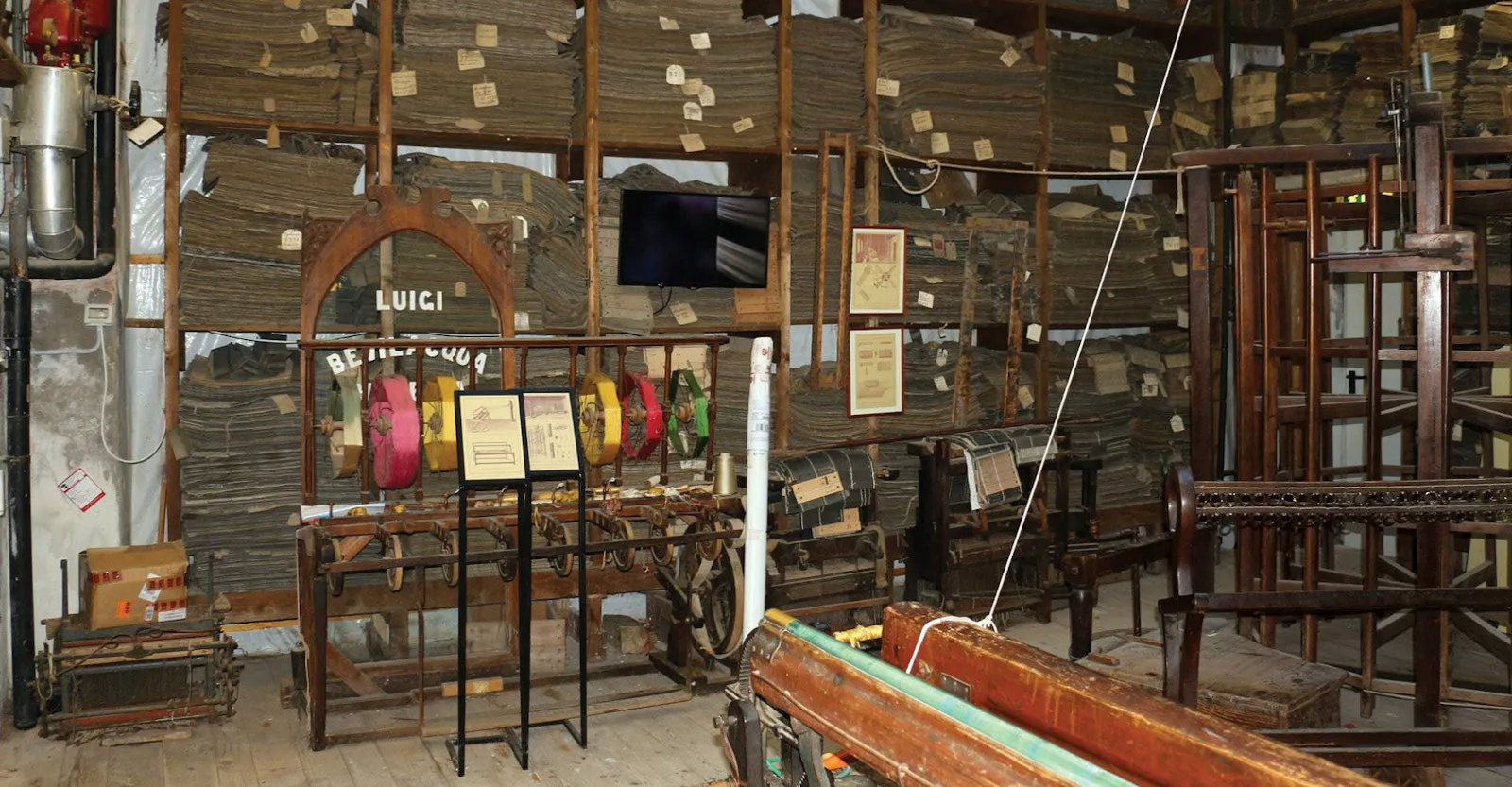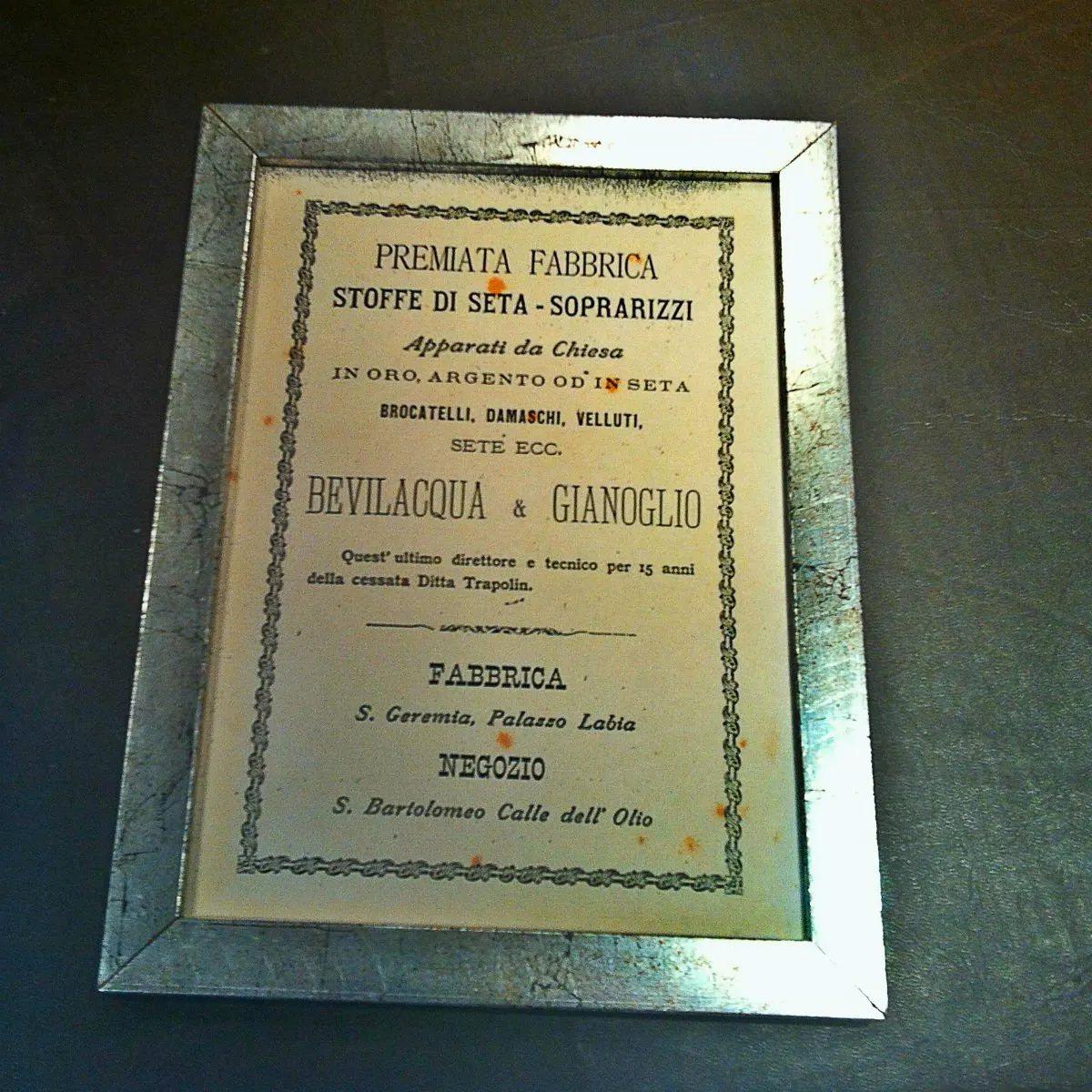Luigi Bevilacqua SRL Weaving: A Legacy of Italian Craftsmanship
Discover the Art of Weaving with Luigi Bevilacqua SRL
Discover the Art of Weaving with Luigi Bevilacqua SRL
Spotlight: Tessitura Bevilacqua
Join author Deb Essen as she visits the Tessitura Bevilacqua Velvet Weaving workshop in Venice.
Deb Essen Dec 23, 2019 - 8 min read
Shelves containing the dobby card archives of the 3,500 designs produced by Bevilacqua since opening in 1875. All photos by Marty Essen.
Tessitura Luigi Bevilacqua’s main entrance is on the Grand Canal in Venice and accessible only by water taxi. Per their directions, we took the vaporetto (water bus) to the Riva de Biasio stop and wound our way on foot to the back entrance into the weaving studio. “Streets” in Venice are narrow walkways winding between the closely packed buildings. After missing our last turn and backtracking, we found the unassuming entrance tucked into a tiny courtyard.
A Brief History
The Bevilacqua family established its first tessitura (weaving studio) around 1700, but family members have been weaving velvet for much longer. In 1499, Giovanni Mansueti painted The Arrest of Saint Mark from the Synagogue, which includes a scroll with the notation “Giacomo Bevilacqua, weaver.” Nearly 300 years later, Luigi Bevilacqua founded the tessitura at its current location, where today, it’s still run by the Bevilacqua family.
ADVERTISEMENTThe building was once the home of the Silk Weaving School for the Republic of Venice, which was closed in 1806 when Napoleon decreed that all of Venice’s craft guilds be shut down. The building’s history was significant to Luigi Bevilacqua, but more importantly, the building contained the Jacquard looms and equipment used by the Silk Weaving School. At one time, all three floors of the building were dedicated to weaving velvet by hand. Today, 18 of the original Jacquard looms, dating to 1801 to 1804, are in use on the first floor of the building.
In its early days, the workshop wove for private individuals, government entities, and the Catholic Church. In fact, well into the 1930s, the Catholic Church commissioned Bevilacqua velvet for curtains, altar cloths, vestments, and ornamentation in cathedrals across Europe. Many palaces, villas, and castles around Europe still contain rooms that have wall coverings and furniture upholstered in Bevilacqua handwoven velvet.
A weaver works on plain velvet. The supplemental pile warp is above the base-cloth warp.
Production of Silk Fabrics in Europe: The Origins
Wool and linen dominated weaving in the Middle Ages. At least until the 12th century, when two new materials spread widely across Europe, cotton and silk, both coming from the East.
Romans already knew silk from the 1st century B.C., but it was a particularly precious material which only a few could afford because of the difficulty in finding it since it was imported from China and the Byzantine Empire.
During the 12th century, with the Second Crusade (1147), the Norman king Roger II of Sicily decided to attack Corinth and Thebes, two important centers of silk production in the Byzantine Empire. Here he discovered and took back to his Kingdom of Sicily the techniques and craftspeople to produce silk, which would later reach Lucca and other Italian cities.
Medieval weavers – “Les Fais et les Dis des Romains et de autres gens” by Valerius Maximus (British Library)
How did our history as Italian fabrics manufacturers begin?
How did our history as Italian fabrics manufacturers begin? We’ve already brought up this topic in some of our old posts. What you maybe don’t know, yet, is who were the first members of the Bevilacqua family who managed the fabric mill.
The old certificate you see in this picture dates back somewhere between 1892 and 1895. Indeed, in 1892 the fabric mill moved to Palazzo Labia. A short digression: the company was born in 1875. So, where was it located, during the 17 years before it moved headquarters? In a building along Fondamenta San Lorenzo, at number 5047, which had previously been occupied by the L. Bistort textile works. Let’s go back to our certificate. Which cannot have been written after 1895, because that’s when Giovanni Battista Gianoglio decided to retire. And to leave the company entirely in his associate’s – i.e. Luigi Bevilacqua’s – hands. That’s what’s written on it:
But why is this certificate so important?
Historical information about Tessitura Bevilacqua
Because this simple piece of papergives us the following information on the Tessitura:



Tegs:
Search
Recent Posts
-
Weaving with Nature: Explore the Art of Cattail Basketry
Apr 14 2025
-
Weaving Mastery: Learn How to String Your Loom Like a Pro
Apr 15 2025
-
Finding Willow Branches for Weaving: Your Guide to Suppliers & Prices
Apr 15 2025
-
Explore the World of Plastic Weaving: Durable & Versatile Materials for Crafting
Apr 16 2025
Subscribe to Updates
Get the latest posts and fashion insights directly in your inbox.